Speech Enhancing Information on Securitisation
Today I would like to do two things. Firstly, I will discuss the current state of play in the securitisation markets. Then I will describe some prospective changes to the Reserve Bank's repo-eligibility criteria for asset-backed securities. These changes will improve the information available to the market about Australian asset-backed securities.
The Current State of Play
I have noted on several occasions at this forum that securitisation markets were likely to take a considerable period of time to adjust to the post-crisis environment. More than five years on since the first wave of investor concerns about structured finance, securitisation issuance is still struggling to recover in most countries.

In the US, new issuance in 2012 to date is a little over half the level seen since issuance peaked in 2006 (Graph 1). RMBS issuance is still exclusively by the government-sponsored enterprises. Private-label issuance of RMBS remains dormant. Some other segments of the market appear to be recovering, particularly securities backed by auto loans and credit card receivables. Australian issuers are tapping this segment of the US securitisation market, as are some European issuers.
In Europe, issuance sold into the market has been negligible since 2008. There has, however, been a large number of securitisations put together that have been retained on the balance sheet of the issuer for use as collateral with the ECB and the Bank of England (Graph 2).
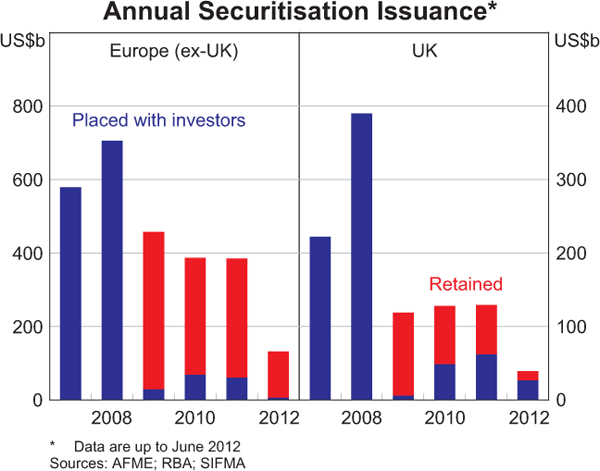
In Australia, RMBS issuance in 2012 has recovered to the point where new issues are replacing maturing issues so the stock outstanding is no longer declining (Graph 3). The issuance in the year to date has totalled $10 billion. By way of comparison, in the second quarter of 2007, at its peak, issuance amounted to $25 billion. Given we are now five years on from that, and although amortisation rates have slowed somewhat from their pre-crisis rate of around 20 per cent per annum, only around 10 per cent of the pre-crisis issuance remains outstanding. Most of the pre-crisis stock comprises issues that have yet to amortise below the 10 per cent threshold required before clean-up calls can be executed, while around 15 per cent was issued by entities that aren't around anymore, such as the old RAMS.
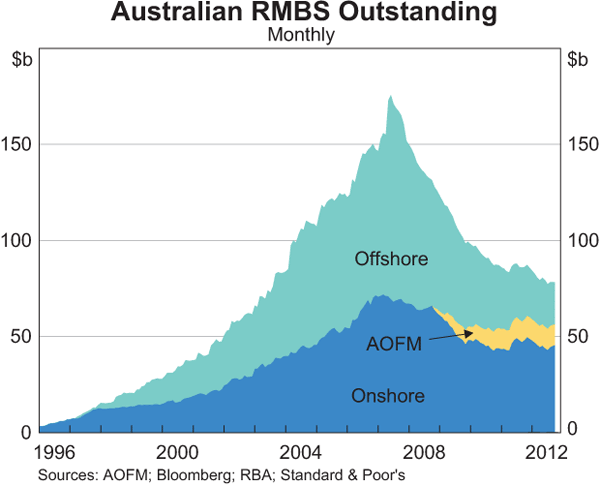
This year we have seen positive signs in the Australian securitised market, particularly over the past several months. First, despite the periodic bouts of turmoil in offshore markets, there has been a steady flow of new issues. Primary spreads have gradually tightened this year and a number of deals have been fully placed with external investors (that is, no tranche has been retained by the issuer), including junior tranches. More recently, several issues have been completed with little or no support from the AOFM due to strong private investor demand. And, of course, the collateral underlying Australian asset-backed securities (ABS) continues to be of high quality, with arrears rates on Australian mortgages remaining low.
The structure of RMBS deals continues to evolve. Issuers have reduced their reliance on lenders' mortgage insurance (LMI), for instance, as credit ratings agencies have discounted the credit enhancement LMI brings to a deal. Instead, issuers have lengthened seasoning periods and increased subordination to enhance credit quality. The average seasoning of 2012 issuance has been 48 months, compared to an average of 36 months over the preceding three years.
Some preference has emerged for bullet structures to minimise prepayment and extension risk for investors. Offshore investors in particular have shown a preference for bullet features, while the domestic investor base is generally more comfortable with pass-through securities. Issuers have looked to incorporate arrangements such as liquidity underwriting and roll-over features to provide bullet-like structures to deals. Of course, there is a limit to the ability of issuers to incorporate bullet-like structures into issues without significant over-collateralisation or liquidity underwriting costs. ABS have always been about passing through cash flows, and prepayment risk must ultimately always be borne (and be paid for) by someone.
This preference has also been evident in the demand for non-RMBS asset-backed securities. Issuance of ABS backed by assets such as auto loans and trade receivables, with their shorter maturity and more predictable cash flow profiles, has quickly returned to (and exceeded) pre-crisis levels (Graph 4).
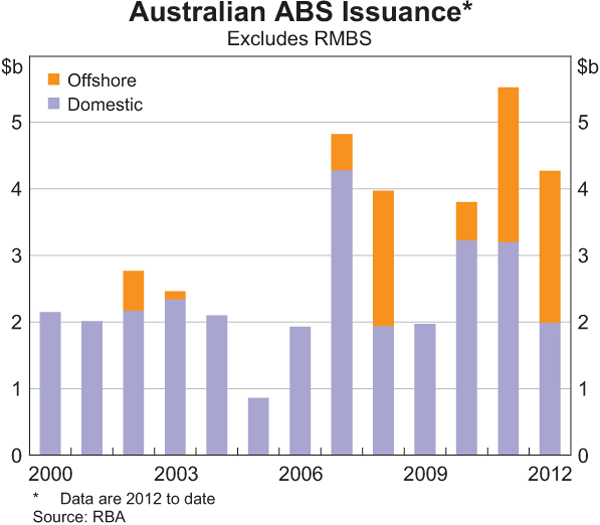
At this forum last year,[1] I said that I thought covered bonds were likely to be used to access funding offshore, while RMBS would continue to be the main vehicle used to raise asset-backed funding onshore. That wasn't quite how it panned out earlier this year, when there were a few very large covered bonds issued domestically. But I think that had mostly to do with the price. Local buyers found it hard to resist the yield on offer on those early covered issues. The wide spreads on the first covered bond issues also repriced primary RMBS spreads to uneconomic levels for both bank and non-bank issuers (Graph 5).
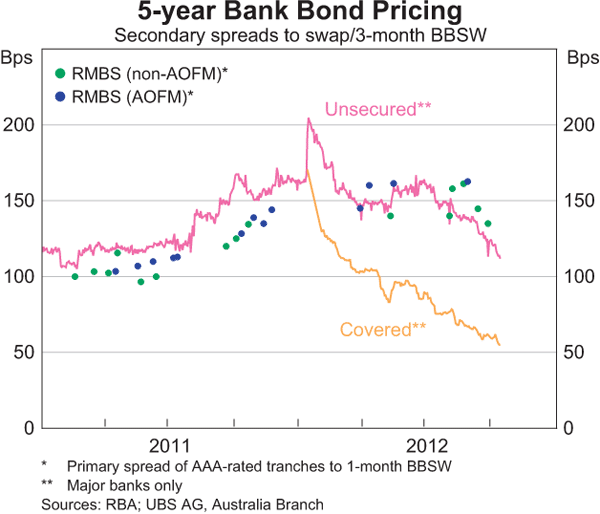
But since then, pricing levels on covered bonds have tightened considerably. Issuance patterns have been more along the lines I expected to occur, with the bulk of recent covered issuance occurring in the offshore market, and at much longer tenors. At the same time, we have seen RMBS issuance pick up in the domestic market, with only a few issues into the offshore market. Twelve months after their inception, banks have issued, on average, around a quarter of their covered bond issuance caps (Graph 6). Covered bonds seem to be performing their expected role of attracting a different investor base and providing an important source of funding diversification for financial institutions.
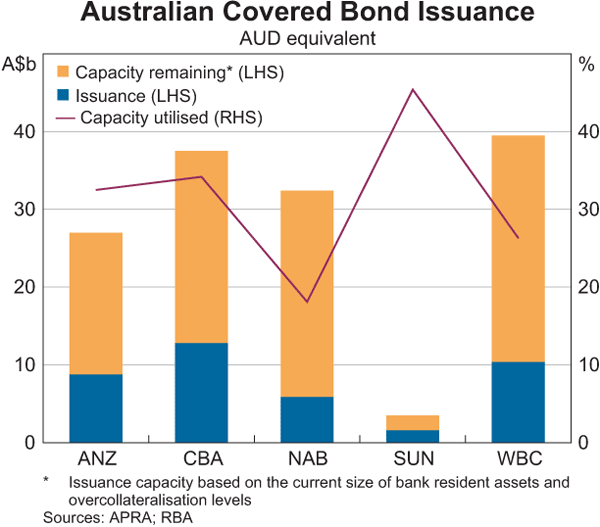
Enhancing Information on Securitisation
While the RMBS market has gradually improved, there clearly remains scope for further improvement, though, as I have said on a number of occasions, you shouldn't expect the market to return to its pre-crisis levels.
One avenue which should help facilitate improvement is enhancing the information available to the market about the securities on issue. With that in mind, I will talk about some changes the Reserve Bank is announcing today that aim to increase the information available.
There is an increasing demand for more transparency in securitisation from both investors and regulators alike. One objective for improving transparency is to ensure that investors, other market participants and regulators all have access to relevant and reliable information in order to monitor risk. Another aim is to improve document standardisation, which can help to stimulate liquidity in securitisation markets.
There are a number of initiatives in various countries, some ongoing and others already in force, that seek to increase transparency of securitisation. This is encapsulated in the IOSCO report on Global Developments in Securitisation Regulation.[2] In relation to standardisation of information, the report proposes that IOSCO members encourage industry to develop best practice templates and encourage industry bodies to work with their counterparts in other jurisdictions to ensure harmonised treatment. The announcement by the Bank today is consistent with the objectives contained in the IOSCO report, and is supported by ASIC.
Similarly, in Europe and the UK, loan-level reporting has also been introduced by the ECB and the Bank of England. As is the case in Australia, the main drivers of this initiative were the need for these central banks to get standardised information on securitisations for internal risk analysis and to provide broader transparency in the market. In the US, the SEC is currently considering what information needs to be provided by issuers as a result of the Dodd-Frank legislation. Proposed rules would require loan-level data underpinning pooled assets being lodged with the SEC in computer readable, standardised format. So, the changes we are making today are part of a global development.
As you are all aware, for around five years now, the Reserve Bank has included asset-backed securities amongst the range of collateral eligible for our domestic market operations.
The self-securitised RMBS proved to be beneficial during the height of the crisis in 2008, as the RBA was able to quickly stabilise funding markets by providing liquidity against them (Table 1). The advantage of having these securities in place is that the Reserve Bank is able to assess their value and quality ahead of time, rather than in the midst of a crisis.[3] Similarly, in recognition of the role that these assets can play in stressed circumstances, APRA has encouraged both large and small ADIs to self-securitise some of their assets and put arrangements in place with the RBA, such as RITS membership (although most ADIs already had them). For large ADIs, these securities will be important from 2015 when the new liquidity regime and the Committed Liquidity Facility (CLF) are in place.[4]
| June 2008 | June 2009 | June 2012 | ||||
|---|---|---|---|---|---|---|
| $ billion | Per cent of total |
$ billion | Per cent of total |
$ billion | Per cent of total(a) |
|
| General Collateral | ||||||
| – CGS | 0.9 | 2 | 2.5 | 6 | 8.5 | 35 |
| – Semis | 4.0 | 7 | 1.2 | 3 | 8.6 | 35 |
| – Supras | 1.5 | 3 | 0.4 | 1 | 0.6 | 2 |
| – Government Guaranteed | – | – | 0.3 | 1 | 0.3 | 1 |
| Private Securities | ||||||
| – ADIs | 45.3 | 82 | 11.8 | 28 | 5.6 | 23 |
| – RMBS (internal securitisations) | – | – | 21.2 | 50 | 0.0 | 0 |
| RMBS (other) | 2.9 | 5 | 4.9 | 11 | 0.8 | 3 |
| – ABCP | 0.3 | 1 | 0.0 | 0 | 0.0 | 0 |
| – Other | 0.0 | 0 | 0.0 | 0 | 0.0 | 0 |
| Total | 55.1 | 42.5 | 24.4 | |||
(a) Sum does not total 100 due to rounding. Source: RBA |
||||||
Even though none of these assets (and few unrelated RMBS) are held on the Reserve Bank's balance sheet now, the fact that they are eligible for repo means that the Bank must always be fully cognisant of the risks these assets carry.
The information currently required for RMBS repo-eligibility is largely about the core attributes of the security. This includes, for example, the information memorandum, high-level data relating to the asset pools backing the securities and a list of mortgage insurers present in the pool. A AAA credit rating is also required.
In part because we felt it was an appropriate time to do so five years after their inclusion on our collateral list, and in part ahead of the introduction of the CLF, the Bank has been conducting an internal review of its reporting requirements for RMBS.
As a result of this review, today the Bank is announcing some enhancements in the information requirements for repo-eligibility of RMBS. In a nutshell, these will require that issuers provide the Reserve Bank and the broader public with more comprehensive and up-to-date information on the securities.
While some information on RMBS is generally available in the market, reporting standards can vary significantly across issuers, since there is currently no regulatory standard for RMBS reporting in Australia. The available data also tend to be dispersed in a number of different locations, making it difficult to gather. Hence, in consultation with the Australian Securitisation Forum (ASF), we have sought to achieve some uniformity and greater depth in the information reported.
Broadly speaking, the new information requirements cover both transaction-related data as well as information on the underlying assets, such as anonymised loan-level data.[5]
Details of the information that will be required at least every quarter on both existing and new RMBS issuance are set out in reporting templates, which are available today on the Bank's website. These templates are aligned with the ASF's current best practice RMBS reporting and disclosure standards. They are also consistent with those developed by the ECB and the Bank of England.
These reporting templates standardise reporting of RMBS data across Australian issuers who seek repo-eligibility of their issues. They will help the Bank to more precisely value the securities held on its balance sheet in terms of both price and risk. They will also decrease the Bank's reliance on credit rating agencies in assessing the securities. As well as applying to those securities issued in the market, these requirements will also apply to self-securitised RMBS.
But just as importantly, these data will also be of benefit to the broader market by providing more transparency to Australian RMBS. The Reserve Bank will also require that issuers make these reporting templates available to the public, free of charge. Issuers will have to inform the Reserve Bank of where their data are being stored and being made available to the public. It will also be a requirement that issuers ensure that these data are accurate.
The proposed reporting templates we've put out today are open for comment until end-December. Again though, I would note that we have worked with the ASF in putting these information templates together. Having taken account of any comments, we will provide final reporting templates early next year. Once that has been done, issuers will have a transition period in which to provide the information. At the end of that period, if the information is not available, the security will no longer be repo-eligible. RMBS issues that do not meet the reporting requirements during the transition period will remain repo eligible.
I encourage issuers to use this transition period to develop the reporting systems and the data handling infrastructure needed to comply with the new requirements.
Furthermore in 2013, the Bank will also make available for comment reporting templates for other ABS, such as securities backed by auto loans or credit card receivables, asset-backed commercial paper (ABCP) and commercial backed securities (CMBS).
In terms of managing public availability of the data, the Bank is placing no specific requirements on where issuers must make these data available, and this is one area of the new requirements on which the Bank is keen to receive industry feedback.
Conclusion
In conclusion, the securitisation market is continuing its gradual recovery. But there is scope for it to recover further yet. One avenue that may facilitate further growth is the availability of more information, and more standardised information, than exists currently.
Today, the Reserve Bank has put out some enhanced information requirements for repo-eligibility of asset-backed securities. These information requirements should not only benefit the Reserve Bank in assessing the quality of the securities provided to it as collateral, but also be of benefit to the market as a whole.
Endnotes
Thanks to Christian Vallence and David Olivan for their help. [*]
Debelle G (2011), ‘The Present and Possible Future of Secured Issuance’, Address to Australian Securitisation Forum, Sydney, 21 November. [1]
IOSCO (International Organization of Securities Commissions) (2012), Global Developments in Securitisation Regulation, Consultation Report, June, available at <http://www.iosco.org/library/pubdocs/pdf/IOSCOPD382.pdf>. [2]
This allows us to lend against good collateral in stressed circumstances, a core function of central banks. [3]
Debelle G (2011), ‘The Committed Liquidity Facility’, Speech to the APRA Basel III Implementation Workshop 2011, Sydney, 23 November. [4]
This will not involve reporting of data on any individual borrowers, thereby mitigating privacy concerns. [5]
